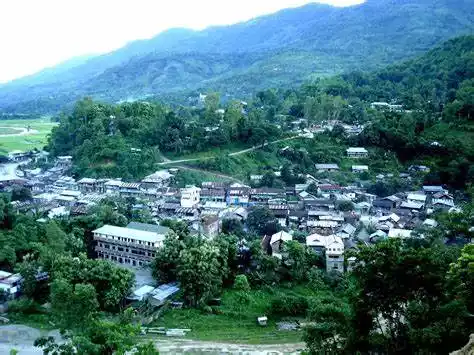Comprehensive Overview of Noney District: Demography, Culture, Geography, and More
Introduction
Noney District, nestled in the heart of Manipur, India, is a region of exceptional beauty and cultural richness. This district, which became operational in 2016, is one of the newest districts in the state, reflecting a blend of traditional heritage and modern development. This comprehensive overview delves into various aspects of Noney, including its demography, culture, geography, topography, cuisines, history, notable poets and authors, and administration.
Demography
Noney District is characterized by a diverse population, primarily composed of indigenous tribal communities. The Rongmei Naga tribe is the predominant group, alongside other tribes such as the Liangmai, Zemei, and Kuki. This demographic composition influences the district's cultural practices, languages, and social structures. The population is predominantly rural, with a significant number of households engaged in agriculture and allied activities.
Culture
The cultural fabric of Noney District is vibrant and deeply rooted in traditional customs and practices. Festivals play a central role in the community life, with celebrations like Gaan Ngai, Chaga Gadi, and Rih Ngai marking important cultural and religious events. These festivals are characterized by traditional dances, music, feasts, and rituals that bring together the community in a spirit of unity and festivity.
Traditional attire, adorned with intricate beadwork and patterns, reflects the rich cultural heritage of the tribes. Handicrafts, particularly weaving and basket-making, are prominent, showcasing the craftsmanship and artistic skills passed down through generations. Oral traditions, including folk tales and songs, are integral to the cultural identity of the district, preserving the historical narratives and wisdom of the tribes.
Geography and Topography
Noney District is located in the western part of Manipur and is part of the larger Tamenglong region. The district is characterized by its hilly terrain, dense forests, and numerous rivers and streams. The Barak River, one of the major rivers in the region, flows through Noney, contributing to the district's fertile valleys and scenic beauty.
The topography of Noney is predominantly mountainous, with elevations ranging from 500 to 2,000 meters above sea level. This rugged landscape is interspersed with lush green forests, home to a rich diversity of flora and fauna. The climate is generally mild, with a significant amount of rainfall during the monsoon season, supporting the dense vegetation and agricultural activities.
Cuisines
The culinary heritage of Noney District is a reflection of its cultural diversity and agricultural abundance. The staple diet consists of rice, accompanied by a variety of vegetables, legumes, and meat dishes. Traditional methods of cooking, using locally sourced ingredients and spices, lend a distinctive flavor to the cuisine.
Popular dishes include smoked meat, fish stews, and bamboo shoot preparations, which are often spiced with indigenous herbs and chillies. Fermented foods, such as fermented fish (ngari) and bamboo shoot (soibum), are also common, adding unique tastes to the meals. Seasonal fruits and wild edibles, gathered from the forests, further enrich the local diet.
History
Noney District has a rich historical background, intertwined with the broader history of Manipur and the Naga tribes. The region has been inhabited for centuries by indigenous tribes who have maintained their distinct cultural practices and social structures. Historically, the area was part of the larger Tamenglong District before it was carved out to become a separate administrative unit.
The district has witnessed various socio-political changes over the years, including the impact of colonial rule and the subsequent struggles for autonomy and recognition of tribal rights. The creation of Noney as a separate district was a significant milestone, aimed at improving administrative efficiency and fostering regional development.
Poets and Authors
Noney District has produced notable literary figures who have contributed to the cultural and intellectual heritage of the region. Prominent poets and authors from the district include those who write in indigenous languages, English, and other regional languages. Their works often reflect the cultural, social, and political themes relevant to the community.
These literary figures have played a crucial role in preserving the oral traditions, folklore, and historical narratives of the tribes. Their writings provide valuable insights into the life, struggles, and aspirations of the people of Noney, contributing to the broader literary landscape of Manipur.
Administration
The administrative structure of Noney District is designed to ensure effective governance and development. The district is divided into several sub-divisions and blocks, each headed by administrative officers who oversee various developmental programs and initiatives. The Deputy Commissioner is the chief administrative officer, responsible for implementing government policies and ensuring law and order.
Local governance is further strengthened by the presence of traditional tribal councils, which play a significant role in resolving community disputes and preserving cultural practices. These councils work in tandem with the formal administrative machinery to ensure that the needs and aspirations of the tribal communities are addressed.
Suggested Diagram
Here is a suggested diagram in mermaid syntax that outlines the administrative structure of Noney District:
Conclusion
Noney District, with its rich cultural heritage, diverse demographic composition, and stunning natural landscapes, offers a unique glimpse into the life and traditions of Manipur's tribal communities. From its vibrant festivals and traditional crafts to its rugged topography and agricultural practices, Noney is a region of immense cultural and ecological significance. As the district continues to develop and modernize, it remains deeply rooted in its historical and cultural legacy, striving towards a future that honors its past while embracing new opportunities.
